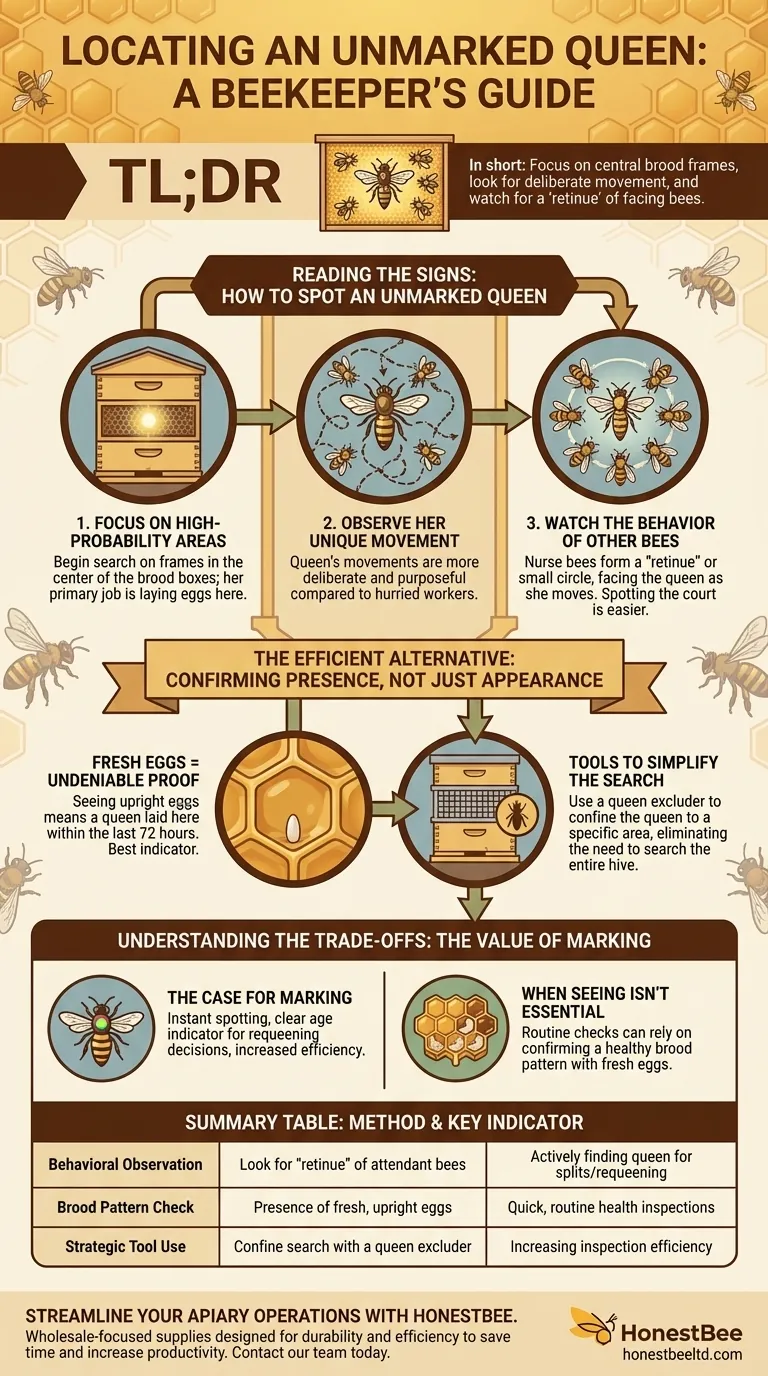In short, you locate an unmarked queen by focusing your search on the central frames of the brood nest. Look for a bee with slightly different, more deliberate movements and watch for a "retinue" of worker bees who turn to face her as she passes.
The most critical shift in strategy for any beekeeper is to move from asking "Where is my queen?" to "Is my hive queenright?". Often, the definitive evidence of a healthy, productive queen isn't seeing her, but seeing the results of her work.

Reading the Signs: How to Spot an Unmarked Queen
Finding an unmarked queen is a skill built on observing subtle cues within the colony. Instead of scanning for a single bee among thousands, you are looking for patterns of behavior and focusing on high-probability locations.
H3: Focus on High-Probability Areas
The queen's primary job is to lay eggs. You should begin your search on the frames in the center of the brood boxes, as this is where she is most likely to be found.
H3: Observe Her Unique Movement
A queen bee moves differently than the thousands of worker bees around her. Her movements are often described as more deliberate and purposeful, while workers can appear more frantic and hurried.
H3: Watch the Behavior of Other Bees
The most reliable sign of a queen's presence is the behavior of the bees around her. Nurse bees will often turn to face the queen, forming a small circle or retinue around her as she moves across the comb. Spotting this court of bees is often easier than spotting the queen herself.
The Efficient Alternative: Confirming Presence, Not Just Appearance
Experienced beekeepers understand that a visual confirmation of the queen is not required for most inspections. The true goal is to confirm the colony is healthy and productive, which can be done more quickly by looking for evidence of her presence.
H3: The Undeniable Proof of Fresh Eggs
Finding recently laid eggs is the single best indicator that a productive queen is present in the hive. If you see tiny, rice-like eggs standing upright in the bottom of cells, you know a queen was present and laying in that exact spot within the last 72 hours.
H3: Tools That Simplify the Search
Using a queen excluder is a simple mechanical way to make inspections more efficient. By placing it between the brood boxes and the honey supers, you confine the queen to a specific area, eliminating the need to search the entire hive.
Understanding the Trade-offs: The Value of Marking
While finding an unmarked queen is a valuable skill, it's worth considering why the practice of marking exists. The decision to mark a queen involves balancing efficiency with the desire for a more natural approach.
H3: The Case for Marking a Queen
Using queen marking pens allows a beekeeper to spot a queen almost instantly during an inspection. It also provides a clear visual indicator of her age, which is crucial for making informed management decisions about requeening.
H3: When Seeing the Queen Isn't Essential
For a routine health check, marking is not essential. As long as you can confirm a healthy brood pattern with fresh eggs, you have all the information you need to know the colony is queenright. Many experienced beekeepers successfully manage their hives for years without ever marking a queen.
Your Inspection Goal Dictates Your Method
How you approach finding your queen depends entirely on what you need to accomplish during the inspection.
- If your primary focus is a routine health check: Prioritize finding fresh eggs and a solid brood pattern; seeing the queen is a bonus, not a necessity.
- If your primary focus is finding the queen for requeening or a hive split: Systematically work through the brood frames, looking for her unique movement and the "retinue" of attendant bees.
- If your primary focus is long-term efficiency and data: Consider marking your queens to make future inspections faster and to easily track their age and productivity.
Ultimately, learning to read the colony as a whole is a more powerful skill than simply being able to spot one bee.
Summary Table:
| Method | Key Indicator | Best For |
|---|---|---|
| Behavioral Observation | Look for a 'retinue' of attendant bees | Actively finding the queen for splits/requeening |
| Brood Pattern Check | Presence of fresh, upright eggs in cells | Quick, routine health inspections |
| Strategic Tool Use | Confine search with a queen excluder | Increasing inspection efficiency |
Streamline your apiary operations with HONESTBEE. Whether you manage a commercial apiary or distribute beekeeping equipment, our wholesale-focused supplies are designed for durability and efficiency, helping you save time and increase productivity. Contact our team today to discuss your specific needs and discover how we can support your beekeeping success.
Visual Guide

Related Products
- Queen Bee Marking Pen UNI Medium Point for Queen and Bee Marking
- Jenter Queen Rearing Kit Complete Set for Bee Breeding
- Nicot Queen Rearing Kit for Beekeeping and Grafting in Nicot System
- No Grafting Queen Rearing Kit: System for Royal Jelly Production and Queen Rearing
- Retractable Chinese Queen Rearing Grafting Tools Equipment
People Also Ask
- What is the purpose of a queen marking pen in beekeeping? Essential for Efficient Hive Management
- What are the advantages of using Uni-Posca markers for Queen marking? A Safe, Precise, and Efficient Solution
- What is the process for priming a paint pen before marking a Queen bee? Ensure a Safe, Quick Marking Procedure
- What are the color codes in the queen-marking system? Master Hive Management with the 5-Year Cycle
- What are the characteristics of Posca pens for marking queens? A Safe, Durable Solution for Hive Management



















